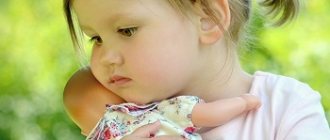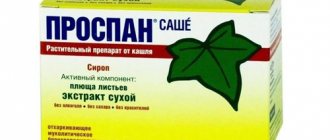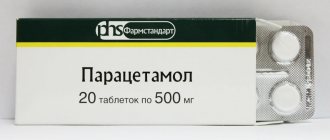Pharmacological properties, forms, indications, limitations, undesirable effects
Sumamed is produced in the form of tablets, capsules, and suspensions . Children's antibiotic Sumamed in bottles contains powder from which the mixture is prepared. 5 ml of the finished medicine contains 100 or 200 mg of the active substance. Tablets have drug concentrations of 125, 250, 500 mg. Capsules may contain 250 or 500 mg of antibiotic. For children, Sumamed syrup is approved from 6 months. Sumamed tablets can be prescribed to children from the age of 6 years. Capsules should be given to children over 12 years of age.
The active component of Sumamed is Azithromycin. It has a negative effect on gram-positive, gram-negative, anaerobic, intracellular bacteria. The drug is quickly absorbed by the mucous membrane of the gastrointestinal tract and spreads through the bloodstream, concentrating in places where pathogens accumulate - inflammatory foci. The active substance prevents the formation of protein molecules of pathogenic microorganisms and promotes the destruction of their cell wall. This process stops the reproduction and activity of bacterial agents. Azithromycin is metabolized in the cellular structures of the liver and then excreted in bile and urine.
Indications and restrictions
Sumamed, according to the instructions, has its own indications and contraindications.
Indications for prescribing the medicine:
- diseases of the respiratory organs (pharyngitis, tonsillitis, otitis, pneumonia, bacterial bronchitis);
- diseases of the skin, subcutaneous fat, muscles (Lyme disease, erysipelas, purulent skin diseases, erythema);
- inflammatory processes of the genitourinary system caused by bacterial agents - cystitis, urethritis, cervicitis;
- diseases of the digestive system caused by Helicobacter pylori.
Before using Sumamed, you should consult a doctor to clarify the restrictions, as well as undesirable manifestations. It is imperative to inform your doctor if you have allergies or concomitant chronic diseases.
Limitations and unwanted effects of Sumamed
Restrictions | Undesirable manifestations |
Relative restrictions:
|
|
Undesirable effects occur very rarely. The most likely side effects of Sumamed in children are diarrhea and vomiting. After a symptom appears, you should tell your doctor about it. In case of severe dehydration, the antibiotic should be discontinued and replaced with another drug (of a different group).
In children, with prolonged use, intestinal dysbiosis may develop, which is accompanied by abdominal pain, stool problems, vomiting, and flatulence. In this case, the antibiotic Sumamed should be discontinued for the child and probiotics should be prescribed to restore the flora.
Sumamed is an ototoxic drug, so if there are complaints of hearing loss, tinnitus, or vestibular dizziness, the drug should be immediately discontinued and the child should be referred for consultation with an otolaryngologist.
Using high doses of medication
Uncontrolled use of Sumamed may increase undesirable symptoms. The child may experience severe diarrhea, vomiting, nausea, bleeding in the digestive tract, and hearing loss. To avoid this, the dosage of children's Sumamed must correspond to the instructions.
If the baby has taken a large amount of medicine on his own, then it is necessary to force him to drink water, induce vomiting , and give sorbents (Activated carbon, Smecta, Enterosgel, White coal). If therapy is ineffective, you should urgently call an ambulance service and hospitalize the child. In the hospital, detoxification therapy will be carried out intravenously, and the stomach will be washed out additionally.
Rules for using an antibacterial agent
At what age can children be given Sumamed? The drug is approved for babies up to 1 year (from 6 months). To treat bacterial infections, you can give your child Sumamed in syrup in acceptable doses. Tablet forms of Azithromycin are indicated for children from 6 years of age. Capsules can be used by children over 12 years of age.
Rules for taking the suspension in pediatrics
The suspension is produced in bottles. To prepare the solution, you need to dilute the powder with boiled or distilled water. One jar is designed for 1 course of therapy. After preparing the suspension, the solution should be stored at room temperature for no more than 5 days. Before each dose, shake the mixture to obtain a uniform suspension. Otherwise, the concentration of the drug may be lower, and the treatment will be ineffective.
How often should Sumamed be given to a child? The package contains a measuring syringe, which makes it easier to accurately dose the antibiotic. The medicine is given at a certain time, preferably in the morning, once a day. You need to take the antibiotic 60 minutes before meals or 2 hours after meals . If a dose of Sumamed was missed, then the medicine should be given at any time when remembered. The next dose is taken after 24 hours. This is necessary to constantly maintain a high concentration of the antibiotic in the blood. The syringe must be washed and dried before the next use so that the piston does not stick and drug residues do not remain.
The course of treatment lasts 3 days. If 3 days is not enough, then therapy can be extended to 5 days . Taking it for more than 5 days can cause dysbiosis, as well as other complications. In this case, it is better to replace the drug with another antibiotic.
How to calculate the dose of Sumamed for a child? The dosage of the drug is calculated depending on the child’s weight, age, severity of the condition, presence of chronic diseases, type and sensitivity of pathogenic microflora.
Sumamed is given to infants strictly according to the instructions. The dosage of the medicine is calculated according to the weight of the child. For children less than 10 kg, use a suspension with a substance concentration of 100 mg per 5 ml, for children over 10 kg - 200 mg per 5 ml. The maximum dose per day is 10 mg per 1 kg of weight, per course no more than 30 mg per 1 kg of weight.
Rules for use in children
| Child's weight (kg) | Amount of drug (ml) |
| 10-14 | 2,5 |
| 15-24 | 5 |
| 25-34 | 7,5 |
| 35-44 | 10 |
| more than 45 | 12,5 |
After the child has drunk the medicine, you need to give water or juice to wash away any remaining medicine in the mouth.
Use of tablet and capsule forms of the drug in pediatrics
For children over 6 years old, it is better to take Sumamed 125 mg tablets. For patients over 12 years of age, 250 and 500 mg forms are suitable . The dosage of tablet forms is calculated based on the child’s weight. For diseases of the respiratory system, 10 mg per 1 kg of patient weight is prescribed. Sumamed is given once at the same time. The intervals between doses should be 24 hours. The tablet or capsule should be washed down with plenty of water without chewing. The course of treatment is 3 days, maximum 5.
If there are other diseases, the dosage of Sumamed for children is selected individually. For erythema, the course of therapy is extended to 5 days. Sexual infections require treatment for 7 days. If bacterial diseases occur, consult a doctor. You cannot take medications on your own, as complications are possible.
Combination of medicine with other groups of drugs
Drugs that affect the acidity of gastric juice, as well as food intake, can reduce the speed and efficiency of absorption of the antibacterial drug. Therefore, Sumamed in the form of a suspension, capsules and tablets is taken before or after meals. The medicine does not affect the cytochrome systems, so it does not interact with theophylline, carbamazepine, and cardiac glycosides.
Sumamed enhances the effect of steroid hormones and indirect anticoagulants. The simultaneous use of Warfarin and Azithromycin requires constant monitoring of the child’s condition and checking the prothrombin time in blood tests. It is prohibited to prescribe Sumamed with heparin. This increases the likelihood of heavy bleeding that is difficult to stop.
Description
Pharmacy chains offer customers the opportunity to purchase the antibiotic Sumamed for children in capsules, in solid form with free-flowing properties (used for preparing suspensions and infusions) and in blisters.
Tablets in a special coating contain 500 or 125 milligrams of the active substance azithromycin. Their characteristic features are:
- blue;
- special engraving with the company name -) on one side of the pill and an indication of the amount of the active component (“500”, “125”) on the other;
- variation in the shade of the medication in the fracture from white to almost white.
Additional components of the tablet form of Sumamed include corn starch, hypromellose, magnesium stearate and other excipients.
Blue gelatin-coated antibiotic capsules contain light yellow (white) powder; it contains 250 milligrams of azithromycin and additional ingredients.
The granulated form of Sumamed in an amount of 17 grams is packaged in brown glass bottles, the volume of which is 50 ml. The kit includes a measuring spoon and/or syringe.
The color of the particles is similar to the contents of the capsules; when dissolved, the suspension may remain white or acquire a light yellow tint.
In addition to 100 mg of antibiotic, 5 ml of the prepared solution also contains sucrose, glycerin, a number of other auxiliary components and flavorings (the presence of the latter gives it a strawberry flavor).
Sumamed for infusion is packaged in bottles, each of which contains 500 mg of azithromycin and a small percentage of additional components. The solution is prepared in a medical facility.
Sumamed's analogs
Sumamed's analogues may be cheaper or more expensive. The price of the drug depends on the pharmaceutical company producing the drug, as well as on the correct adherence to the production technology. The cheaper the medicine, the greater the likelihood of side effects. This is due to a violation of the technological requirements stated by the manufacturer of the drug Sumamed. Before choosing a drug, you should definitely consult your doctor. He will help you choose a drug. This will reduce the likelihood of unwanted manifestations.
Similar medicines in tablets, capsules | Sumamed suspension, analogues: |
|
|
In our country, Azithromycin is produced in suspension, tablets and capsules, AzitRus in tablets and capsules. These drugs have a very low price. Hemomycin is produced in Serbia. The cost of the medicine is slightly higher. More expensive are Zitrox in suspension, Azitral, Z-factor in tablets and capsules. Of the entire list, Hemomycin has proven itself well. It has a low price and good quality.
Rules for assessing the effectiveness of Azithromycin
When prescribing Sumamed, you should definitely look at the effect of treatment. To assess the effectiveness of therapy, the attending physician must evaluate temperature data, the general condition of the child, the occurrence of undesirable effects, and signs of inflammatory reactions.
The temperature is recorded at least 2 times a day (more often if necessary). A graph is constructed against the background of these measurements. If during the first day while taking Sumamed the curve on the graph decreases below 38, then the effect of therapy is good. On the second day the temperature should return to normal. If jumps in the temperature curve remain above 37 during the first 2 days, then the antibiotic is not helping. Maintaining a temperature in a high range is an indication for discontinuing the drug or replacing it with another group of antibacterial agents.
In addition to temperature, when treating skin diseases, the doctor evaluates the condition of the skin. While taking Sumamed, the focus of inflammation should decrease. If a child has pneumonia, a control x-ray is required to assess the size of the darkening. During treatment, the darkening will be less intense, and the pulmonary pattern will begin to disappear. The general condition of the child, with a good effect from the treatment, will be satisfactory on the second day of taking the medicine.
If Azithromycin is not suitable, it should be replaced with another antibacterial drug. To do this, a sputum analysis or smears from the skin and throat are performed to determine sensitivity to antibiotics. Based on the examination results, the doctor selects a drug.
Contraindications in children
In addition to the body's excessive sensitivity to macrolide antibiotics, such as azithromycin and erythromycin, the main contraindication for children is exceeding the permissible dosage. Therefore, the drug in different forms is intended for different ages.
Contraindicated:
If you have fructose intolerance or diabetes mellitus, use powder for suspension with caution. Contraindications include hypersensitivity to azithromycin and impaired renal or liver function.









